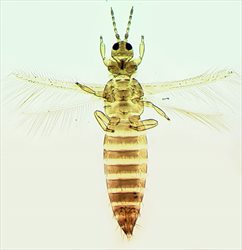
Female
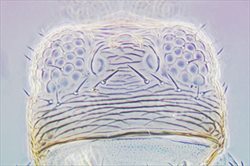
Head

Head & pronotum

Antenna
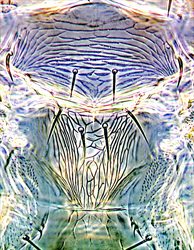
Meso & metanota
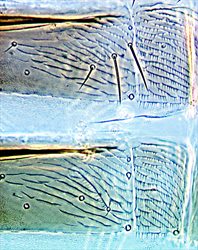
Pleurotergites V-VI
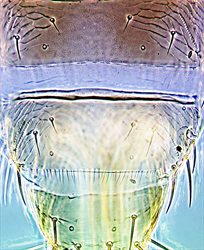
Tergites VII-IX
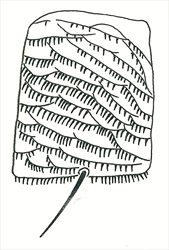
Pleurotergite II

Tergites VII-IX
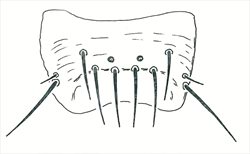
Male tergite IX

Fore wing
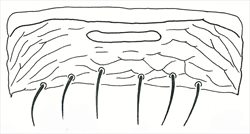
Male sternite V
Both sexes fully winged. Adult females vary greatly in size and colour, from small and yellow to large and dark brown, depending on temperature during development (the yellow form is rare in Britain, more common in southern Europe; in Britain, females are predominantly brown); ocellar pigment usually grey, never red; fore wings pale. Antennae 7-segmented; segments III–IV each with short forked sense cone; VII short. Head wider than long, with 2 pairs of ocellar setae; pair III small, arising on anterior margins or just within ocellar triangle; postocular setae pairs I–III about equal to ocellar setae III. Pronotum with 2 pairs of posteroangular setae; posterior margin with 3 (or 4) pairs of setae. Mesonotum without anterior pair of campaniform sensilla; median setae far ahead of posterior margin. Metanotum irregularly reticulate medially with lines converging to midpoint at posterior margin; median setae short, arising behind anterior margin; campaniform sensilla absent. Fore wing first vein usually with 4 (varying 2–6) setae on distal half; second vein with about 15 setae. Abdominal tergite II with 3 lateral marginal setae; V–VIII with paired ctenidia, on VIII posteromesad to spiracles; tergite VIII posteromarginal comb complete, microtrichia long and slender; tergite IX with only one pair of campaniform sensilla, X with median split; pleurotergites without discal setae, with closely spaced rows of fine ciliate microtrichia. Sternites without discal setae.
Males usually rare, small and yellow; tergite VIII with marginal comb represented by few irregular microtrichia; sternites III–V with narrow transverse pore plate about 6 times as wide as long.
The genus Thrips is the second largest genus in the Thysanoptera, and currently includes, worldwide, over 290 species. All members of genus Thrips lack ocellar setae I on the head, and they all have ctenidia on tergite VIII posteromesad to the spiracles. Other characters, such as number of antennal segments, number of setae on the fore wing veins, and number of discal setae on the sternites are variable between species (Palmer, 1992; Nakahara, 1994; Mound & Masumoto, 2005). T. tabaci is unusual within the genus in lacking red pigment around the ocelli, and is usually easily recognized by the closely spaced rows of ciliate microtrichia on the pleurotergites, although the latter character state is shared with Thrips euphorbiicola and Thrips origani.
Feeding and breeding, also often pupating, in the flowers and on the leaves of its host plants. It is highly polyphagous, and can be predatory on small mites on leaves. Widespread outdoors in Britain, where it is found on numerous types of plant (Morison, 1957). Economically, the Onion Thrips is particularly associated with Allium species, but it also breeds on many other vegetable crops, including carrots and cabbages. Until the arrival of Frankliniella occidentalis, the Onion Thrips was the primary pest thrips of commercial glasshouse production in Britain.
Originally from the Eastern Mediterranean area, the Onion Thrips is found everywhere in Britain, as well as across the island of Ireland (Mound et al., 1976; O'Connor, 2008), and also throughout Europe. It has been distributed around the world wherever onions and garlic are grown.
THRIPIDAE - THRIPINAE
Thrips tabaci Lindeman
Thrips tabaci Lindeman, 1889: 61
Limothrips allii Gillette, 1893: 15
Thrips communis Uzel, 1895: 176
Thrips communis var. annulicornis Uzel, 1895: 177
Thrips communis var. pulla Uzel, 1895: 177
Thrips communis var. obsoleta Uzel. 1895: 187
Thrips bremnerii Moulton, 1907: 59
Parathrips uzeli Karny, 1907: 48
Thrips bicolor Karny, 1907: 49
Thrips brachycephalus Enderlein, 1909: 441
Thrips hololeucus Bagnall, 1914: 24
Thrips adamsoni Bagnall, 1923: 58
Thrips debilis Bagnall, 1923: 60
Thrips mariae Cotte, 1924: 2
Thrips frankeniae Bagnall, 1926: 654
Thrips seminiveus Girault, 1926: 1
Thrips tabaci f. irrorata Priesner, 1927: 436
Thrips tabaci f. nigricornis Priesner, 1927: 436
Thrips tabaci f. atricornis Priesner, 1927: 437
Thrips dorsalis Bagnall, 1927: 576
Thrips shakespearei Girault, 1927: 1
Thrips indigenus Girault, 1929: 29
Thrips dianthi Moulton, 1936: 104
Ramaswamiahiella kallarensis Ananthakrishnan, 1960: 564
Morison GD (1957) A review of British Glasshouse Thysanoptera. The Transactions of the Royal Entomological Society of London 109 (16): 467–534.
Mound LA & Masumoto M (2005) The genus Thrips (Thysanoptera, Thripidae) in Australia, New Caledonia and New Zealand. Zootaxa 1020: 1–64.
Mound LA, Morison GD, Pitkin BR & Palmer JM (1976) Thysanoptera. Handbooks for the Identification of British Insects 1 (11): 1–79.
Nakahara S (1994) The genus Thrips Linnaeus (Thysanoptera: Thripidae) of the New World. United States Department of Agriculture. Technical Bulletin 1822: 1–183.
O’Connor JP (2008) A review of the Irish thrips (Thysanoptera). Irish Naturalists’ Journal 29: 20–24.
Palmer JM (1992) Thrips (Thysanoptera) from Pakistan to the Pacific: a review. Bulletin of the British Museum (Natural History) Entomology Series 61 (1): 1–76.